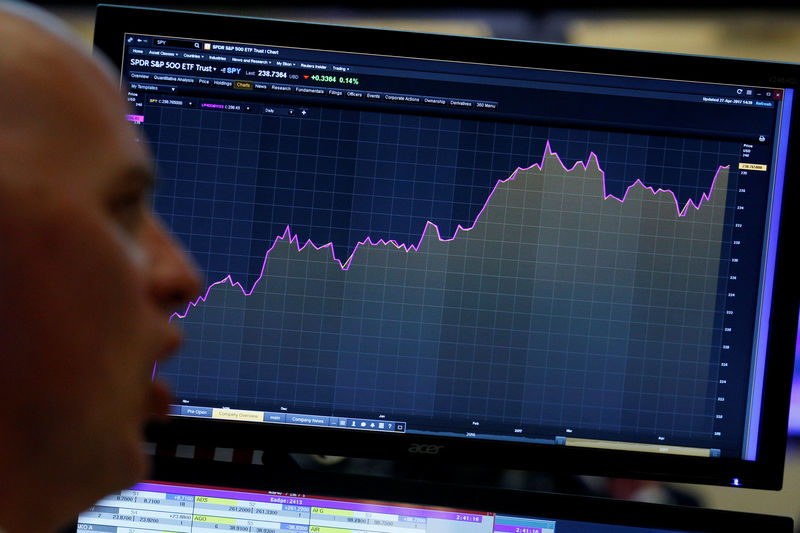By Noel Randewich
SAN FRANCISCO (Reuters) - A funny thing happened on Wall Street in Donald Trump's first 100 days in the White House: Shares of companies that got closest to the president lagged the market's march higher.
Meanwhile, stocks from sectors that have had less access, and have faced occasional bluster from Trump, such as media and technology, have hopped into the driver seat.
Banks, industrials and other companies expected to win from Trump's policies surged following his unexpected election victory in November. Valuations for many grew stretched.
But Wall Street's change in focus in recent months also reflects concerns among investors that Trump may struggle to enact deep tax cuts and stimulate economic growth as quickly as previously expected. Indeed, the economy grew just 0.7 percent on an annualised basis in the first quarter, the first of Trump's presidency, as consumer spending stalled.
Many of the industries Trump singled out for special attention, like coalminers, steelmakers and oil companies, face major market trends and commodity price fluctuations that he can do little to change.
Since Trump's inauguration on Jan. 20, representatives from nearly 100 publicly-listed companies have visited the White House, with carmakers, healthcare companies, banks and industrials getting more face time than technology companies, retailers and media firms.
Shares of companies that have visited the White House since the inauguration have enjoyed a median increase of 3.7 percent, trailing the benchmark Standard & Poor's 500 Index's gain of 5.5 percent.
But Trump's recent failure to push a healthcare overhaul through Congress, as well as other miscues, now have investors a little less sure he will be able to make good on his promises.
The S&P 500 is near record highs after the administration unveiled a long-awaited proposal Wednesday to steeply cut corporate tax rates. But the plan may be unpalatable to Republican fiscal hawks since it lacks proposals for raising new revenue and would potentially add billions of dollars to the federal deficit.
"The stability of the market and its ability to rise is still based on the feeling that the administration may be getting its act together," said Tim Ghriskey, chief investment officer of Solaris Group in Bedford Hills, New York. "But at some point investors will ask if any of this stuff is going to happen or if it's all talk."
- For graphics on 'S&P performance by sector' click: http://tmsnrt.rs/2oT1zRO
- For graphics on 'Presidential markets' click: http://tmsnrt.rs/2ptQvgZ
- For graphics on 'Currency and bonds: hope vs reality' click: http://tmsnrt.rs/2oTbh6I
- For graphics on 'Who has Trump's ear ' click: http://tmsnrt.rs/2qbI3DF
EARLY WINNERS FADE
Since the election, the financial sector (SPSY) has risen 19 percent, more than any other. But its gain since the inauguration has been among the weakest, at 3 percent.
An investor buying a basket of banks and selling utilities immediately after Trump's election would have made as much as 29 percent by mid-February. But that gain has since shrunk to 17 percent, according to Vincent Deluard, Vice President, Global Macro Strategy at INTL FCStone Financial Inc.
Other "Trump trades" have lost momentum.
Investors bet big on steel right out of the gate after Election Day, with the industry seen as a poster child for Trump's focus on "unfair" trade deals that hurt U.S. producers. The S&P 1500 steel industry group index <.SPCOMSTEEL> had gained 36 percent by the first week of December.
The group is down by more than 13 percent since then, however, and even last week's executive order to investigate whether U.S. steel companies need additional trade protections under the auspices of national security delivered only a short-lived rebound. Poor earnings from sector heavyweight United States Steel Corp (N:X) ruined the party.
Trump this month signed an executive order sweeping away Obama-era climate change regulations, saying it would end America's "war on coal." But reflecting an abundance of cheap natural gas and falling costs of wind and solar power, coal miners CONSOL Energy (N:CNX) and Cloud Peak Energy (N:CLD) have dropped 16 percent and 32 percent, respectively, in Trump's first 100 days.
Meanwhile, tech stocks that were left out of the early Trump rally have surged recently as investors shift out of low-valuation stocks favoured immediately after the election and back into high-growth stocks like Alphabet (O:GOOGL) and Facebook (O:FB) that delivered much of the market's momentum in recent years.
In the absence of concrete results from Trump, corporate earnings have taken centre stage, with first-quarter profits of S&P 500 companies expected to surge 13.6 percent, helped by strong international growth.
"Earnings are through-the-roof good. Companies are very profitable, and potentially are going to be more profitable with tax-cut legislation," said Stephen Massocca, Senior Vice President at Wedbush Securities in San Francisco.
Other stocks seen as out of favour under Trump have also outperformed during his first 100 days.
Tesla (O:TSLA), which some investors feared could be hurt by the removal of tax incentives for the purchase of its electric vehicles, has surged 27 percent to record highs.
And perhaps most telling of all, the media sector - regularly lambasted by Trump for its coverage of him - is up 7 percent since he took office.

Even New York Times Co (N:NYT), publisher of what Trump has repeatedly disparaged as "the failed New York Times" newspaper, hit a three-year high after the inauguration and is up 10 percent since he moved into the White House.